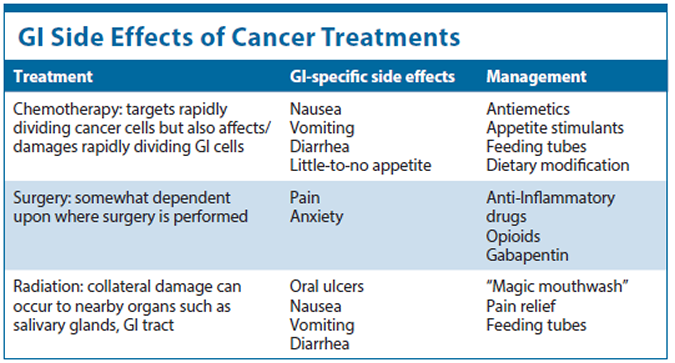Wjen to Feed Cat After Chemotherapy

Weight loss can be tough to see because it's so gradual. You should weigh your cat every week if possible. The sooner you recognize she's losing weight, the sooner you can address the problem.
Like people, many cats with cancer suffer from muscle wasting and weight loss even if they eat normally. This condition is called "neoplastic cachexia." In a cancer state, a cat's energy needs are usually increased and glucose production increases. Muscle and fat breakdown may occur simultaneously, as the cancer competes for energy.
Adjusting the Diet
In some cases, the physical nature and location of the tumor cause the cat to become anorexic, while in others the tumor affects the cat's desire to eat and/or utilize nutrients.
"If the cancer involves the gastrointestinal (GI) tract, a cat may have trouble absorbing nutrients," says Margaret McEntee, DVM, DACVIM, DACVR, professor of oncology at the New York State College of Veterinary Medicine at Cornell. "Or if it has oral cancer, it may have trouble eating. It's not uncommon that a cat with cancer will not eat well and will lose weight,"she says.
Tumor cells preferentially use carbohydrates to promote their growth. As a result, dietary recommendations for feline cancer patients are for foods with a high fat content and no more than 25% carbohydrates on a dry matter basis. These properties can be difficult to find in most adult cat foods, and there are no cancer-specific diets on the market. Your best bet is kitten food. Many meet this nutritional recommendation and can be used for your adult cat with cancer.
Making nutrients easily available to the digestive system will improve absorption. For example, cobalamin (vitamin B12) deficiency commonly occurs with gastrointestinal lymphoma, the most common feline cancer. To combat this, your veterinarian may supplement your cat's vitamin B12 with under-the-skin injections.
Managing Appetite
Obviously, a highly palatable and digestible food is important, but the cat needs to want to eat it, too. Encourage your cat by using the juice from a can of tuna mixed with her regular diet or diluted with some water to drink.
Almost any meat or fish choice that is warmed up slightly will give off strong odors to help entice the cat. Sick cats often have an impaired sense of smell, so "stinky" foods may get their attention. "You will become a good customer of all those tiny, expensive cans of cat food," says Katherine Houpt, VMD, Ph.D., ACVB, Cornell University Emeritus Professor of Behavior Medicine. "Do not stock up on one flavor; for example, feed salmon on Monday, turkey on Tuesday, beef on Wednesday." Adding bits of meat can also make mealtime more exciting.
Treatment Side Effects
Managing side effects is critical to maintaining appetite. Radiation and chemotherapy can cause nausea, vomiting, diarrhea, oral ulcers, and anorexia. Medications to combat these include ondansetron (Zofran), metoclopramide (Reglan), and maropitant (Cerenia). Each of these drugs works in a different area of the body, and they can be used together to manage severe GI symptoms. They can be given by injection if a cat is unwilling to take oral medications or is vomiting.
Prebiotics and probiotics may help reestablish disrupted intestinal bacterial populations that lead to diarrhea. Metronidazole (Flagyl) has immunomodulating effects in the gastro-intestinal tract and can improve diarrhea.
In cats suffering from oral ulcers, "Magic mouthwash" can help. This is a compounded slurry often containing lidocaine, diphenhydramine (Benadryl), and sucralfate, a coating agent, to soothe oral and esophageal burns.
As the Cancer Worsens
Feeding tubes may become necessary. Esophagostomy tubes are placed via an opening in the neck and advanced to the end of the esophagus. Food and medications can be placed into them. These tubes can be left in place for months and can help prevent food aversion while a cat undergoes chemotherapy and/or radiation.
A feeding tube is not an easy decision, and quality of life considerations and long-term goals are important to assess. If the tube is a temporary bridge, it may be an excellent option. If all other options have been exhausted, and a patient still refuses to eat, reevaluation of goals is worth considering.
Managing a cat with cancer can be challenging, even with close attention to the cat's eating. Keeping your cat comfortable, well fed, and pain-free should be your goal.
Click image to enlarge

forrestertakedent.blogspot.com
Source: https://www.catwatchnewsletter.com/features/feeding-the-cat-with-cancer/
0 Response to "Wjen to Feed Cat After Chemotherapy"
Post a Comment